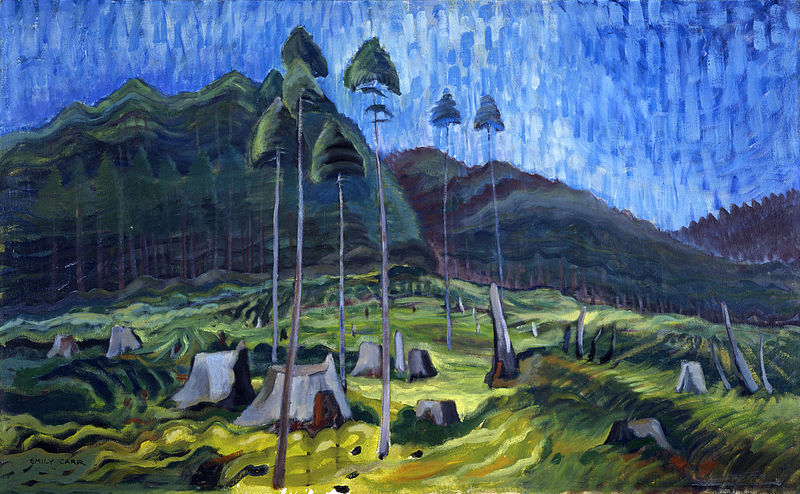Emily Carr is one of the most famous painters in Canada history. The Canadian Encyclopedia describes her as a “Canadian icon”. Her profound interpretation of natural scenery and culture in her works earned her the title of “Nature poetess”. She was born in 1871 in Vitoria B.C. when she was young, she studied at in San Francisco in the United States. In 1899, she came to England, went to Westminster School of Art and then to St. Ives artists’ residence. In the end, she came to Hector Academy of Arts in Hertfordshire, but she failed due to severe anemia. She spent eight months in a sanatorium before returning to Canada, and later worked as a newspaper illustrator in Victoria. She was settled in Vancouver in 1905. After that every summer, she went to an Indian village to paint from life and drew a batch of meaningful totem poles. In 1910 she went to study at the Académie Colarossi in Paris, but only in a short time, and then she returned home because of illness. In 1912, she held an exhibition of French period works in Vancouver, which was characterized by the style of Fauvism (It is the earliest painting school of art nouveau symbolism in the 20th century. It is characterized by wild color use and strong visual impact, usually gives people an irrational feeling.) and aroused the interest of audiences and critics. The second year, she was disappointed that the Indian Village landscape exhibition, which was in the same style, did not receive a positive response. So, she went back to Victoria and decided to stop the painting.

Emily Carr – Self-portrait
In 1927 Emily Carr selected 26 paintings for took part in the West Coast Aboriginal art at the National Gallery in Ottawa. Her work was placed in the center of the gallery and was well received by the audience. This is big change because this is her first time met the “Group of Seven” (Group of Seven based on their love for the wild nature of northern Canada, they intended to create a painting style that was different from the Traditional European painting style and truly represented the true Canadian painting style. They use bold and exaggerated techniques to reproduce the unique Canadian natural scenery with varied pictures. The Group of Seven is the first Canadian art group to take the initiative to discover the original beauty of Canada. Their works and spirits encouraged the newcomers and aroused Canadians’ interest and love for their vast land. They are an important spiritual force and part of the growth of Canada as an independent country), and She was greatly encouraged. After this meeting Emily Carr ends 15 years of artistic isolation. It brings her Paintings into its most productive and famous period. In the following summer she made an audacious voyage across the Queen Charlotte Islands, along the Snares and Nass rivers into the Canadian interior. In a batch of paintings from this trip, Carl abandoned his early style altogether and accepted Lawren Harris’s monumental style and boldly generalized forms of inspiration. In 1930 she exhibited with the Group of Seven, and totem poles were exhibited at the Victoria and Seattle Museum of Art. Later, she abandoned the obvious Indian theme, and in paintings like The Great Forest of British Columbia, she represented the rainforest itself with the heavy sculptural feel of a rainy forest. Later, when she stopped traveling and sketching, she also tried to show the stacked timber and curving coast, as well as the cloud-filled effect.

Photo by Joe Mabel
Emily Carr’s spirit people would never forget. There is a university in Vancouver called “Emily Carr University of Art + Design”. It was built in 1925. It is the oldest institution in British Columbia that specializes in arts, media and design education. Also, are one of the four largest independent arts schools in Canada. Emily Carr University of Art and Design is recognized worldwide as an institution of innovation and excellence in visual arts, film and television arts and design right now. It has 1,250 students, mostly international students from Canadian provinces, 15 U.S. states, and 24 countries around the world. The courses offered at Emile Carr University of Art and Design are divided into three major areas: design, media arts, and visual arts. QS world university rankings in 2017, art and design professional rankings, Emily Carr University of Art and Design in third place, Canada UBC after the first and second, at the university of Toronto is Canada’s only comprehensive university college of art and design, but the identity of the professional school into the university of art and design in university rankings.

Cited:Vancouver Art Gallery
The Vancouver Art Gally have a lot of Emily Carr’s paintings and now is in the exhibition until December 13, 2020. Do not miss your chance to take a look. Also, you can buy the “Emily Carr: From The Vancouver Art Galley Collection” from Art Gally’s online store.

Paintied by Emily Carr
More Detail:https://www.vanartgallery.bc.ca/exhibitions/rapture-rhythm-and-the-tree-of-life
Onlin Store:::https://www.vanartgallery.bc.ca/exhibitions/rapture-rhythm-and-the-tree-of-life

